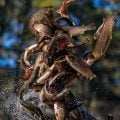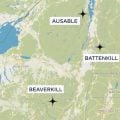How to Tie a DPD Nymph
Producer: Tim Flagler
I call this fly the DPD Nymph. It reasonably imitates a range of mayfly nymphs and because of it’s weight and its relatively slim profile, sinks super fast. It makes for an excellent anchor fly.
I start with a Partridge heavy-wire Czech nymph hook in size 14. Getting hold of the hook with plunger-style hackle pliers makes handling easier. Pick up a 7/64” black nickel bead and feed it onto the hook, small hole first, then get the assembly firmly secured in the jaws of your tying vise.
.02 lead-free wire is used to add still more weight and to stabilize the bead. Four or five wraps to start is plenty. A drop of Fly Tyers Z-ment applied to the hook shank between the weight and the bead will really help to lock things in place and allow you to finish wrapping the wire without the whole thing spinning around the hook shank.
For thread, I load a bobbin with a spool of brown UTC 70 Denier. Get your thread started on the hook shank immediately behind the weight and take a few wraps rearward before snipping or breaking off the tag. Take a few more wraps to establish a short thin thread base on the shank.
Small copper Ultra wire is used to rib the fly and protect the delicate pheasant tail fibers below. A 10” length is enough to make numerous flies. Butt the wire against the weight wraps on the near side of the hook and take wraps of tying thread to secure it. Continue a fair ways down into the bend. If you want, reorient your hook like so in the vise to make tail tie-in much easier.
For the tail, isolate the tip of a well marked wood duck or mallard flank feather from the rest of the fibers. Snip the tip fibers off but don’t discard the rest of the feather. Measure to form a tail about a hook gap in length and secure the fibers to the top of the hook shank. You can then reorient the hook to its normal position and continue taking thread wraps to bind the fibers down, up to the weight. There, snip the excess fibers off close. Pick up the remaining part of the duck feather and tuck it away for safekeeping.
The abdomen and wing case of the fly are made of rusty brown pheasant tail fibers. Locate the side of the feather with the longer, stiffer fibers and strip 6-8 free from the stem. It’s a good idea to snip the curlies off so they don’t get caught on things. Also, snip the brittle tips off square. Butt the tip end of the fibers against the weight and make tight turns of tying thread to bind them to the top of the hook shank. Wrap all the way down to the base of the tail. Get hold of the fibers and start wrapping them around the hook shank behind your tying thread. This will help the them to stay together as you wrap. When you reach the weight, anchor the fibers with a few tight turns of tying thread then snip the excess off close.
Use the copper wire to make open spiral counter wraps over top of the pheasant tail. When you reach your tying thread, go around the wire with it to reverse the direction of your thread wraps. This will ensure the wire gets bound down really well. With the wire secure, use it once again to change the direction of thread wrap back to normal. You can then helicopter the wire to break it off close.
On the shorter, webbier side of the pheasant feather strip a dozen or so fibers free from the stem. Here too, it’s a good idea to snip off the curlies. With the fibers somewhat spread out, allow them to roll over top of the hook to create a nice, wide wing case. Then take wraps of tying thread to bind them down tight.
The thorax of the fly is created using two peacock herls. Snip the delicate tips off square then place them on top of the hook shank and take thread wraps to secure them. Again, make wraps behind your tying thread to keep the herls together. When you reach the bead, secure the herls with a few turns of tying thread then snip the excess off close.
Now, locate that duck feather you stashed away and corral the fibers on one side before snipping them off. Their tips should be roughly aligned. Lay the fibers diagonally across the top of the hook shank, behind the bead and take a couple of thread wraps to lightly secure them. This will allow you to pull the fibers until they form legs about half a hook shank in length. Repeat this same procedure with the fibers on the other side of the feather. This can be a little delicate and fussy but just take your time, go easy and you’ll get it. Once you’re happy with the orientation of the fibers, take a final thread wrap to lock them down then use just the very tips of your tying scissors to snip the excess butt ends off close.
Next, pull the pheasant tail fibers forward, out over the bead, between the sets of legs, to form the wing case. Take 2 or 3 very tight turns of tying thread to bind them down. Then snip the excess butt ends off as close as possible without cutting anything else in the process.
Rather than whip finish here, I’ll just reach for the UV cure resin to reinforce and build up the wing case. I really like the way this stuff magnifies the fibers below. Turn on the UV torch and use it to cure the resin. It usually only takes a few seconds to completely harden.
Even though you didn’t whip finish, you can now snip your tying thread off close knowing the resin will keep it from unraveling. And that’s the DBD Nymph. It’s a great early season pattern that gets to where the fish are quick.
How to Tie a Douglas Salmon Camp Swinger
How to Tie a Dropper Tag Knot











